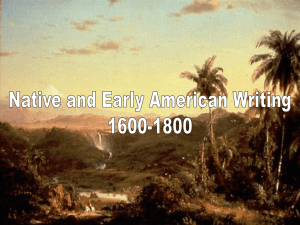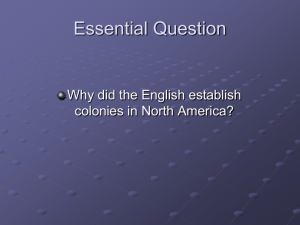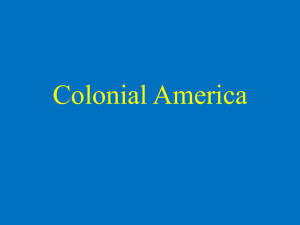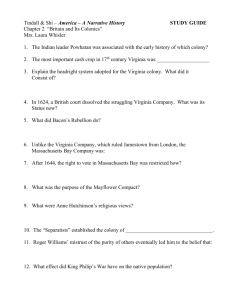File the american colonies emerge
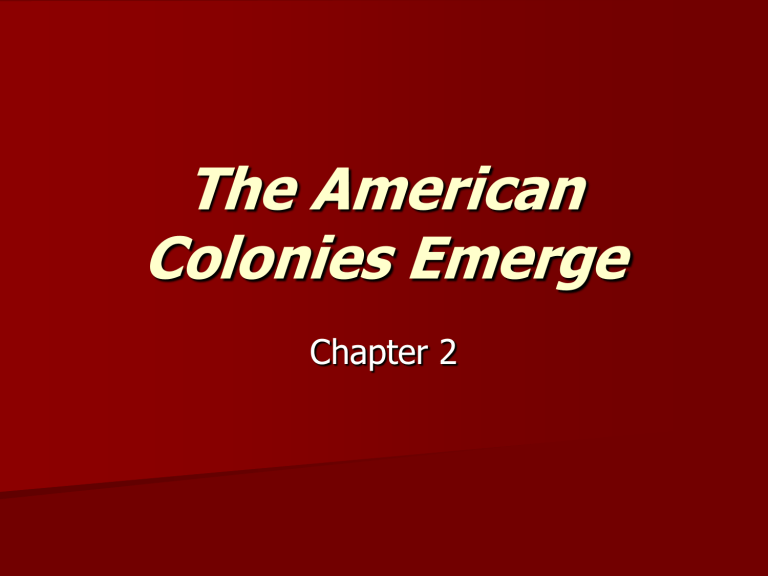
The American
Colonies Emerge
Chapter 2
Virginia
With the support of strong monarchs and capital from investment companies, England began to plant settlements in North America.
The first successful one was at Jamestown,
Virginia (1607).
Virginia
Early English Failures
Humphrey Gilbert secured a royal charter and private investment to start a colony in Newfoundland failed.
Sir Walter Raleigh’s “Virginia” settlement on Roanoke
Island vanished.
Virginia
The Jamestown
Settlement
Two Companies were chartered to settle
Virginia.
Many died in the early going due to disease and starvation.
Captain John Smith dominated the colonial council and enforced strict rules.
Chief Powhatan offered assistance to the English.
Virginia
The Jamestown Settlement
John Rolfe married
Pocahontas, Powhatan’s daughter, and planted
Tobacco.
Tobacco cultivation added to strain between English and
Native Americans.
Native Americans pressured to convert to Christianity led to conflict.
Warfare ended with a treaty
“reorganizing” English authority.
Virginia was reorganized into a royal colony in 1624.
Virginia
Virginia Society and Government
Over 60% of the settlers arrived as indentured servants.
Later 50 acres were granted to stockholders who transported themselves to Virginia.
1619 90 young women were sent to the settlement by the London Company.
1619 Dutch brought first slaves to Jamestown.
1619 the first General Assembly of Virginia met in Jamestown. (including governor, councilors, and burgesses)
Southern Colonies
Like the pioneer settlement in Virginia, other
Southern Colonies featured plantation
economies growing staple export crops that required a supply of field labor.
Southern Colonies
Maryland
The Second Chesapeake Bay plantation colony was founded in 1634 by Lord Baltimore
(a.k.a. George Calvert).
Profit motive was combined with refuge for Roman
Catholics.
An Act of Toleration was passed in 1649
As in Virginia, tobacco was profitable, demand for field labor, primarily indentured servants, but also African-
American slaves.
Southern Colonies
The Carolinas
King Charles II granted a charter to eight court favorites to land between
Virginia and Spanish Florida.
Encourage immigration by granting religious toleration.
Split into North and South Carolina in
1729.
Southern Colonies
North Carolina
Populated by migrants from Virginia.
Reputation for democratic independence.
Chief exports tobacco and timber.
Southern Colonies
South Carolina
First populated by slave owning planters from
Barbados.
Native Americans sold as slaves by others.
Plantations produced rice and indigo.
Port of Charleston had aristocratic and cosmopolitan feel from
French Protestant settlers.
Southern Colonies
Georgia
The last English mainland colony founded in 1732.
Military buffer between Carolinas and Spanish Florida.
General James Oglethorpe, founder, promoted prison reform, sought to make to colony a refuge for debtors.
Initially alcohol and slaves were forbidden in colony.
Large number of Germans settled there.
In 1753, charter expired, Georgia became a colony.
Puritan New England
The Puritans were
English religious dissenters, many of whom migrated to
Massachusetts.
From there the
Puritan influence spread to other New
England colonies.
Puritan New England
Puritanism
A faction within the church of England, return
Christianity to its pure roots.
Criticized the Anglican Church for keeping too many
Catholic rituals.
Stressed the ideas of Predestination, divine grace, and good works.
Religion should be part of daily life and government.
Congregationalists challenged the idea of centralized church-state control.
Separatists broke from the English Church.
Puritan New England
The Great Migration: flight of Puritans from England to the New World 1629 –
1640.
King Charles I grants charter to Puritan controlled
Massachusetts Bay
Company.
50,000 left England most to
West Indies.
Motivated by a religious mission and economic opportunity.
Boston became the “hub” of the New England settlements.
Puritan New England
The “Bible
Commonwealth”
A religious society.
Loyal to a purified Church of England.
Each congregation was self governing.
Clergy were a powerful elite but did not claim political power.
Puritan New England
General Court
(legislature) elected adult male church members owning property.
Democratic roots lay in individual congregational control and town meetings.
Puritans emphasized
“work ethic” and material progress.
Puritan New England
“Blue Laws” stressed observance to the Sabbath, moderation in worldly pleasures
Puritan New England
Conflicts
Quarrels and challenges to Orthodoxy plagued the “peaceable kingdom”.
Massachusetts became the “mother” of other New England colonies.
“Responsibility for fellow men” resulted in lack of privacy and intolerance.
Puritan New England
Rev. Roger
Williams advocated separation of Church and State and Native
American land claims, banished in 1636 founded the colony of
Rhode Island.
Puritan New England
Anne Hutchinson was exiled in 1638 for advocating direct contact with the divine to seek salvation.
Moved to Rhode
Island.
Puritan New England
Thomas Hooker led migrants seeking better land into
Connecticut Valley.
Its General Court adopted the
Fundamental
Orders of
Connecticut in1639
(constitution)
Puritan New England
Salem, MA (1692) witchcraft trials 20 deaths 100 imprisoned.
Puritan New England
As Puritan enthusiasm declined, council of ministers adopted the “Half-way
Covenant” in 1662, permitting partial membership in the congregation.
Puritan New England
John Winthrop:
(1588-1649) An
English lawyer,
Puritan who moved to the Massachusetts
Bay colony.
Repeatedly elected
Governor.
First President of the
New England
Confederation (1643)
Colonial Turmoil
Colonial stability was periodically shaken by conflict, sometimes rejecting changes in
England, more often resulting from tensions in
America.
Colonial Turmoil
Native Americans
Frequently clashed with the colonists
When the Pequot
Indians resisted white expansion in
Connecticut, the
English and Indian allies virtually wiped out the tribe (1637)
Colonial Turmoil
Native Americans
King Philip’s War (1675 – 1676) Indian attacks on Puritan towns, inflicted heavy casualties. Failure to form tribal alliances crippled the Native American resistance in New England.
Colonial Turmoil
Bacon’s Rebellion, 1676
A major popular uprising.
Falling tobacco prices, scarcity of land for freed indentured servants, and fears of Indian attack contributed to tensions on the Virginia frontier.
Under-representation in the colony’s legislature and resentment toward William
Berkeley, the royal governor, added to the unrest.
Colonial Turmoil
Bacon’s Rebellion, 1676
After clashing with the Indians, rebels under the leadership of Nathaniel
Bacon marched on Jamestown and burned the capital.
Bacon suddenly died and the rebellion was crushed.
The uprising reflected tensions between tidewater aristocrats and poorer, politically deprived, frontiersman.
A new Royal governor was ordered to restrict colonial independence or political autonomy.
Colonial Turmoil
Imperial Control
Continued to tighten under King James II
The Dominion of New England
was created to unify colonial administration
(1686).
Charters were revoked, assemblies dissolved, and Governor Andros of
Massachusetts was given extraordinary powers.
Colonial Turmoil
The Glorious Revolution (1689)
Replaced James II with the Protestant monarchs William and Mary.
Massachusetts colonists overthrew Governor Andros
In New York (Leisler Rebellion) and Maryland, popular uprisings deposed governments temporarily.
The Glorious Revolution reassessed parliamentary power in London, but Royal control was re-imposed on the
American colonies.
Middle Colonies
The colonies that developed between
New England and the
Chesapeake Bay attracted a variety of religions and nationalities and soon developed thriving economies.
Middle Colonies
Dutch New York: Henry
Hudson
Sailing for the Dutch East
India Co. seeking Northwest
Passage, 1609 found Hudson
River. Established fur trading posts on Manhattan Island and at Fort Orange (Albany)
New Amsterdam, capital, was built on land purchased from
Native Americans by Peter
Minuet.
Middle Colonies
Dutch New York: Henry
Hudson
The Dutch expanded and absorbed Swedish settlements on the Delaware River.
Population remained sparse.
New Amsterdam was a
“company town” offering little religious or political toleration.
A mixed population, including
English on Long Island, was poorly governed.
Middle Colonies
English New York:
King Charles II (Eng.) granted area to brother,
James, the Duke of York after Anglo-Dutch Wars.
The Dutch surrendered to
British fleet without battle in 1664.
Black slaves 1/5th of New
York City population.
Dutch influence remained.
Middle Colonies
New Jersey
Established in 1664 when
Duke of York turned land between Hudson and
Delaware Rivers over to noble landlords.
Divided into East and
West Jersey.
Combined into one colony in 1702.
Middle Colonies
Pennsylvania
Established as a refuge for Quakers by William
Penn.
Quakers believed in direct inspiration from God.
Refused to defer political authority, persecuted in
England.
Penn offered religious toleration.
Middle Colonies
Pennsylvania
Quakers were pacifists and treated Native
Americans fairly.
German and Scotch-Irish settlers did not relate to
NA as well.
Some Germans retained culture (Penn. Dutch).
Pennsylvania offered more political involvement by freemen.
Middle Colonies
Pennsylvania
A wide variety of national and religious groups attracted to colony.
Philadelphia prospered economically rivaling
Boston.
Farms produced abundant grain.


